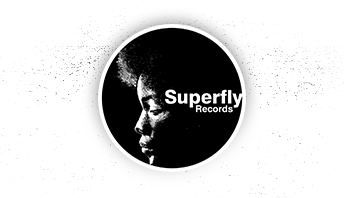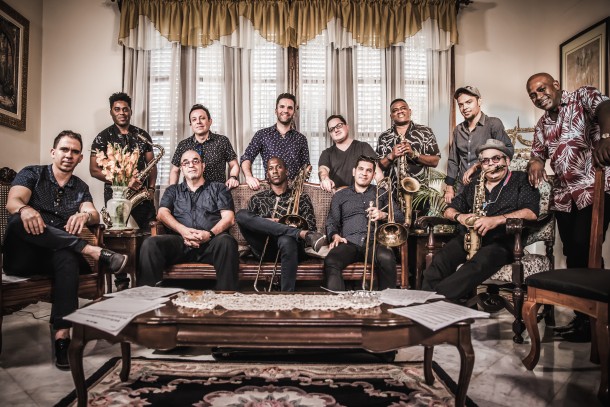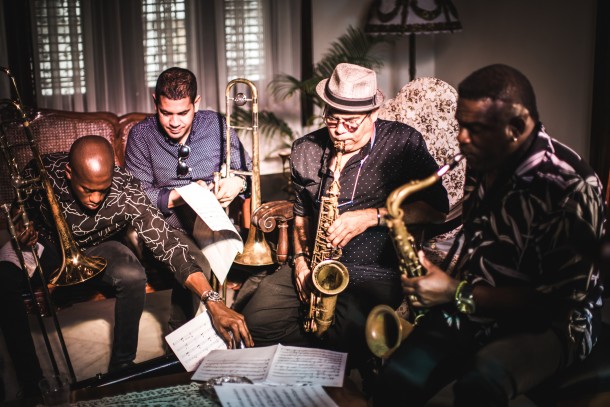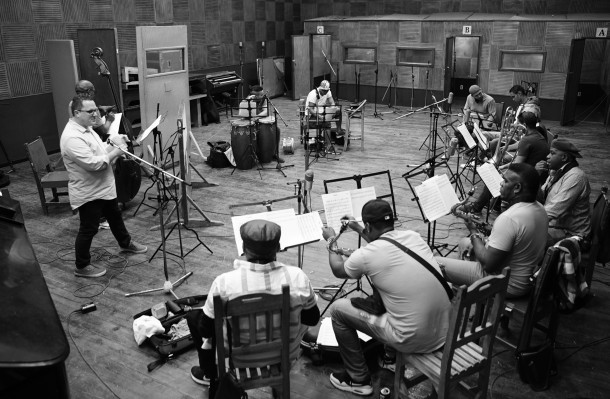



Photos by Adrien H. Tillmann
This LP is one of the latest good news arrived from Cuba: this All Stars orchestra goes back to the good old mambo, to give a version faithful to the spirit of the origins, without being just a poor copy. At the beginning of this adventure, the producer Jacob Plasse returns on the genesis of this combo, somewhere between New York and Havana.
How was this orchestra born? Did you discover it or just set it up? tell me the beginning of the story…
Mike Eckroth, whom I had worked with on previous projects and is the arranger on this album, played me some of the less well-known music of Beny More and Perez Prado, and I became obsessed with it; I realized that this music was the apotheosis of so much music I loved – son cubano, Arsenio Rodriguez, Duke Ellington and guaguanco. Pepito, a good friend of mine who would sometimes play in my son group Los Hacheros, and I began taking some of his tunes and figuring out how they might be reconfigured for this instrumentation. At the same time I began writing tunes with Mike Eckroth, which we would then send to Pepito to write the lyrics. The process felt very organic and like we were discovering something new together.
We tried to record a couple songs in New York, and though these recordings were encouraging, they didn’t quite have the magic that I thought the music deserved. Pepito was going to Cuba to play with Pupi y los Que Son Son, and he thought we could record the tunes there, which to me felt like a pipe dream that would never happen due to the logistical difficulties. But slowly we began ironing out the details with the help of Pepito’s childhood friend, Cesar Lopez (saxophonist from Irakere), who did an incredible job corralling the crème de la crème of Havana’s musicians to be a part of the recording.
You did not put any violins, cello, in that band… So any reference to the typical charanga. To focus on wood and sax, what does that change in terms of sound, energy ?
We were intent on focusing on the sound of brass and saxophones with percussion- the sound of mambo. You will notice that even the piano and tres parts are played pretty sparingly so that the focus can be on the brass, sax and percussion. There is an elemental energy when you combine these sounds, it has an energy and sound like nothing else – it somehow reminds me of early punk rock.
At the center of the orchestra there is José Pepito Gomez. Can we talk about a leader?
Pepito has always been one of my favorite singers. He is able to combine the sound of many styles and eras of latin music into a singular voice, and it was an honor for me to have him as part of the project. I would be hard-pressed to tell you who the leader of the band is; it’s the result of Pepito’s, Mike’s and my combined efforts in bringing this project to fruition, and the amazing artistry of the Cuban and New York musicians who brought the music to life.
How was built – written – the songbook?
All the songs are original, but we tried to keep a stylistic cohesion to the album so that it really brings you into a sonic world of its own.

La Cosa
Who decided on the choice of guests, including Cesar Pupy Pedroso?
Me and Pepito discussed it a lot, and while it’s always nice to have stars perform on an album, it was more important that whomever the guest was really understood the style and intent of the music. And we were so lucky to get Pupy to perform, because besides being a legend and incredible innovator of Cuban music, he understands the lineage and history of the music as well as anyone; his father and uncle played with all the greats as well.
In the short presentation for the press, you talk about the influence of the 50s, Perez Prado, Cachao or Arsenio Rodriguez …. Yet the album makes me think especially of Beny Moré … An influence so essential for Akokan?
For sure! This album was inspired by all the artists you mentioned, but Beny More and his band is for me the pinnacle of Cuban music; and it’s hard for me to describe his music, except to say he did what Duke Ellington, Louis Armstrong or James Brown did for American music – through his vision and musicality Beny combined the folkloric and popular musics of his day into something wholly new.
The mambo is of course very present, but we also hear other styles, as salsa dura. Why this thematic choice, a kind of old school taste. A reply to the current timba and salsa played those days?
It was important for us to not be trapped into replicating the past, but figuring out ways to express our lives within this particular sonic world; we love the sound of mambo, but it has to be true to the world we live in now. But despite the technological advancements involved in recording, I feel that older records sound better, they are more alive and have greater sonic personalities. Most modern salsa and timba recording sound rigid and stale to me, so I tried hard to capture the magic I heard in the music of older albums by researching how they were recorded, mixed and mastered.
What are the songs talking about? Cuban news or love story? From mysticism to music or more down-to-earth realities?
The lyrics are very much true to Pepito’s personality, as he wrote them all. And they run the gamut – love, fame, betrayal, santeria rituals, and double entendres galore.
Can we talk about a revival group? And how is this record (band, repertory) still souring «modern»?
While I agree that there is a definite affinity with older albums, I don’t think this is a revival group in any way: we play entirely original repertoire, and we have many modern musical elements. You can hear this in the way Pepito soneos have the cadence of salsa dura, the way in which La Corbata Barata ends in a McCoy Tyner-esque jazz sound or in the modern wide open harmonies of the intros to songs like No Te Hagas. There is a vintage sound to the production, but that is because I love the way old recordings sound and feel that is the best way to express our musical ideas.
You have chosen to record in the studio of Egrem (Areito), and not in Miramar for example. The warm mood of the wood? The big main room on the first floor? The vibrations of the old sessions done here? Is this choice an essential factor in the success of the album?
I think the choice of Egrem is essential to the recording, for the reasons you mentioned. A huge room, the wood, the ghosts of the legends of Cuban music.

Mambo Rapidito
How long have you been recording?
I’ve been learning about recording for about a decade, and with every album I realize how much I still have to learn. With the recording of this album, I began to think more about how so many different contexts were intersecting and reacting in the music. When you listen to ‘Dolor Carabali’ by Beny More for example, on one level you are listening simply to a beautiful piece of music. And as a musician you can consider how the harmonic, rhythmic and melodic choices guide the listener through the singers story. As a recordist, you begin to hear what choices were made in placing the musicians in the room, and how reverb and other effects were used to create the haunting nature of the recording. And as someone interested in history, you can hear how cubans, and particularly afro-cubans, express their lives through their music, through their interpretation of rhythm and harmony and interaction with the other musicians. And this is what I find so fascinating about the music, that through studying all these different lenses you can glimpse into the interior lives of a people in a time and place that no longer exists.
Why not publish this record on your label, Chulo Records?
That was my initial idea, but then I presented the album to Daptone. As we talked, it became clear they had a strong vision for how to present the album, and it seemed like a natural fit. They were so wonderfully supportive as soon as they heard it. What is so great about Daptone is that they really care about good music, and are very thoughtful and caring about how they present the music to an audience.